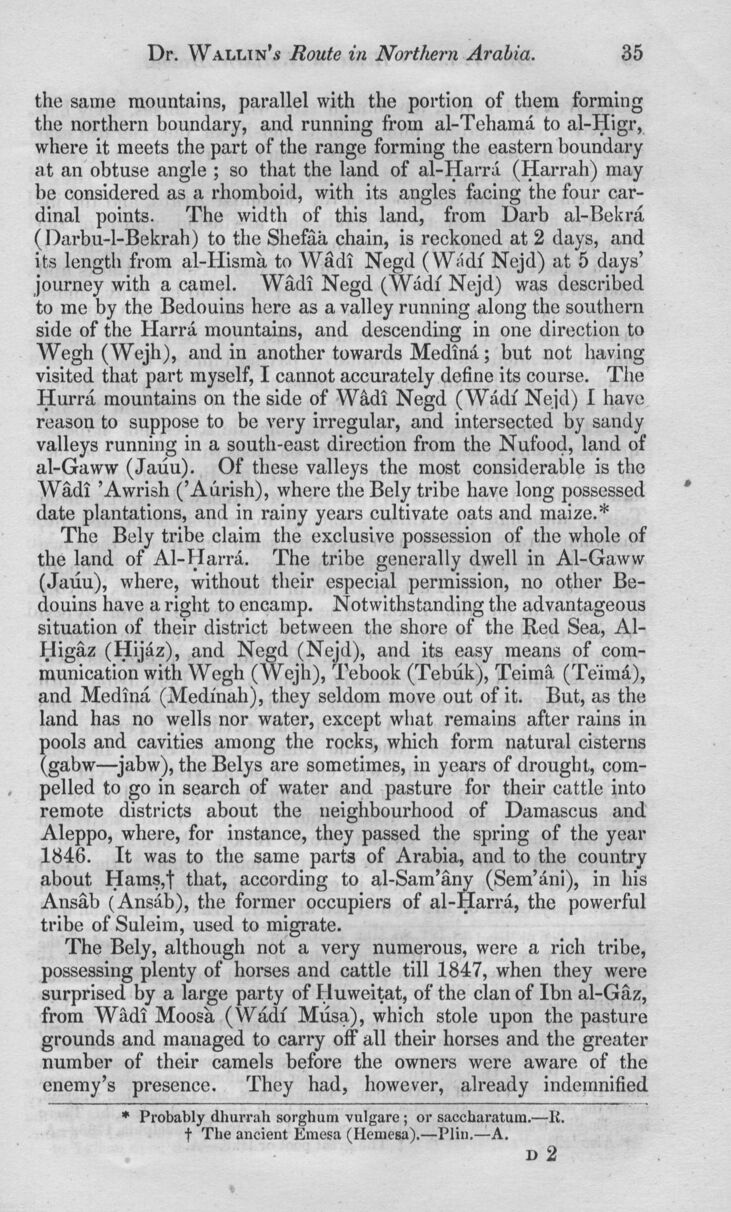
Full resolution (JPEG) - On this page / på denna sida - Route in Northern Arabia

<< prev. page << föreg. sida << >> nästa sida >> next page >>
Below is the raw OCR text
from the above scanned image.
Do you see an error? Proofread the page now!
Här nedan syns maskintolkade texten från faksimilbilden ovan.
Ser du något fel? Korrekturläs sidan nu!
This page has never been proofread. / Denna sida har aldrig korrekturlästs.
[-the-]{+Dr. VVallin’s Route in Northern Arabia.
35
the+} same mountains, parallel with the portion of them forming
the northern boundary, and running from al-Tehama to al-Higr,
where it meets the part of the range forming the eastern boundary
at an obtuse angle ; so that the land of al-Harra (Harrah) may
be considered as a rhomboid, with its angles facing the four
cardinal points. The width of this land, from Darb al-Bekra
(Darbu-l-Bekrah) to the Shefaa chain, is reckoned at 2 days, and
its length from al-Hisma to Wadi Negd (Wadi Nejd) at 5 days’
journey with a camel. Wadi Negd (Wadi Nejd) was described
to me by the Bedouins here as a valley running along the southern
side of the Harra mountains, and descending in one direction to
Wegh (Wejh), and in another towards Medina; but not having
visited that part myself, I cannot accurately define its course. The
Hurra mountains on the side of Wadi Negd (Wadi Nejd) I have
reason to suppose to be very irregular, and intersected by sandy
valleys running in a south-east direction from the Nufood, land of
al-Gaww (Jauu). Of these valleys the most considerable is the
Wadi ’Avvrish (’Aurish), where the Bely tribe have long possessed
date plantations, and in rainy years cultivate oats and maize.*
The Bely tribe claim the exclusive possession of the whole of
the land of Al-Harra. The tribe generally dwell in Al-Gaww
(Jauu), where, without their especial permission, no other
Bedouins have a right to encamp. Notwithstanding the advantageous
situation of their district between the shore of the Red Sea,
Al-iligaz (Hijaz), and Negd (Nejd), and its easy means of
communication with Wegh (Wejh), Tebook (Tebtik), Teima (Te’imd),
and Medina (Medinah), they seldom move out of it. But, as the
land has no wells nor water, except what remains after rains in
pools and cavities among the rocks, which form natural cisterns
(gabw—jabw), the Belys are sometimes, in years of drought,
compelled to go in search of water and pasture for their cattle into
remote districts about the neighbourhood of Damascus and
Aleppo, where, for instance, they passed the spring of the year
1846. It was to the same parts of Arabia, and to the country
about Hams,t that, according to al-Sam’any (Sem’ani), in his
Ausab (Ansab), the former occupiers of al-Harra, the powerful
tribe of Suleim, used to migrate.
The Bely, although not a very numerous, were a rich tribe,
possessing plenty of horses and cattle till 1847, when they were
surprised by a large party of Huweitat, of the clan of Ibn al-Gaz,
from Wadi Moosa (Wadi Musa), which stole upon the pasture
grounds and managed to carry off all their horses and the greater
number of their camels before the owners were aware of the
enemy’s presence. They had, however, already indemnified
* Probably dhurrah sorghum vulgarc ; or saccharatum.—K.
t The ancient Emesa (Hemesa).—Pliu.—A.
D 2
<< prev. page << föreg. sida << >> nästa sida >> next page >>